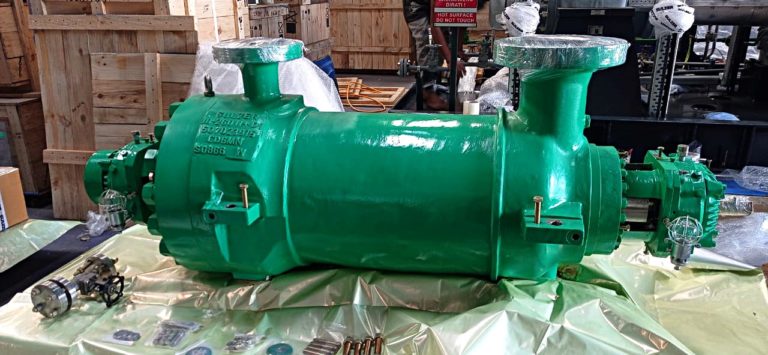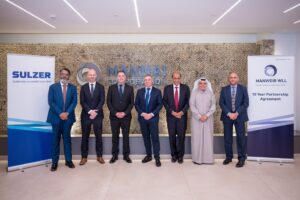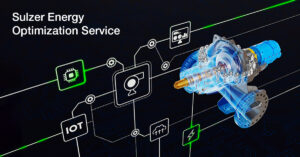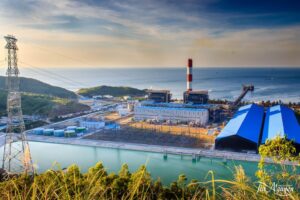Condensate Pumps Retrofitted by Sulzer Offer Fourfold Improvement in MTBF

Using dimensions from the customer, Sulzer redesigned the pump with a new drop-in assembly. (Image source: Sulzer Ltd.)
Pumps for any application are designed to take fluid at a certain pressure and deliver it at an increased pressure and at a specific flow rate. If these figures are kept relatively constant, the pump should continue to provide reliable service for many years. However, moving too far away from the original specifications, for example lowering the flow rate, can drastically reduce efficiency as well as reliability.
Escalating risks
In offshore applications, pumps are used for many tasks and their reliability is essential for continued productivity. Therefore, regular maintenance and inspections are carried out to ensure future performance. Ideally, pumps in this environment should be able to operate for around three years without a maintenance intervention and if the mean time between failures (MTBF) starts to drop, a solution needs to be found quickly.
So, when an offshore platform in Malaysia started to experience problems with its condensate pumps, which were suffering from seal leaks and excessive vibration, it was important to promptly find the cause and resolve the problem. All three condensate pumps, which operate as two duty, one standby, had performed well since installation. However, more recently, output from the platform had dropped and the condensate flow rate had been reduced from 93 m3/hr to 46 m3/hr; following this parameter change, the MTBF dropped to around 12 months.
At this point, the platform operator contacted the original equipment manufacturer (OEM) to find a solution. However, the only suggestion was to install new pumps designed for the current application data; this solution was outside the required scope both in terms of investment and time for delivery. This led to Sulzer being approached for an alternative solution that would help the customer ensure production continuity on its platform with minimal lead-time and without substantial capital outlay.
Retrofitting expertise
The original concern from the platform’s operator was that the mechanical seals were failing, and this was causing unexpected downtime. Further investigation found that the seal leaks were caused by excessive vibration, a result of the pump operating far away from its best efficiency point.
Sulzer’s expertise as a pump manufacturer and a OEM-agnostic provider of retrofit solutions enables it to offer reconfigured components that will fit in the original casing and deliver the new specifications for the task. All of which were delivered through its OEM-X line service, the universal repair service from Sulzer. In cases such as this, where a BB5 style pump needs to be updated, the usual approach is to design and manufacture a new cartridge, laser scanning the legacy pump to ensure precision dimensions. All the other components are usually retained to keep the project as cost-effective as possible.
However, due to restrictions imposed at the time as a result of the global pandemic, it was not possible for Sulzer’s technicians to be on-site and execute the pump scanning. On the other hand, due to the frequency of seal failures, the operator also preferred for the pump to remain on the platform. Therefore, using the external dimensions of the pump provided by the operator, Sulzer’s manufacturing plant in India produced a highly accurate new pump assembly that was a drop-in fit for the legacy equipment.
Fast return on investment
The design retained the original mechanical seal system, which performed very well during the testing phase. The pump went through rigorous tests at Sulzer’s service center before being shipped to the platform for installation. Thanks to the precision manufacturing capabilities, the pump was quickly in place without any changes to the surrounding infrastructure. Having been successfully commissioned, the pump has been operating reliably since.
Radhika Bajpai, Retrofit Specialist for Sulzer, comments: The redesigned pump has a power requirement of 216 kW, compared to the original 370 kW, enabling the original electric motor to be retained and operate well within its capacity. Of greater significance to the platform operator, the mean time between repairs for the new pump is calculated to improve to 48 months, which will reduce maintenance costs dramatically.
As a result of these savings, the return on investment for this project will be just two years. Following the success of this project, the operator wants all three pumps to be identical to minimize the spare parts inventory and make the most efficient use of resources. Therefore, the same retrofit will be carried out for the remaining two pumps in the near future.
API 610 standards recommend pumps that are in continuous operation should be designed to operate without any maintenance interventions for a minimum of 36 months. Sulzer’s aim is to far exceed this standard and offer its customers a greater peace of mind for their pump operations.
Source: Sulzer Ltd.





